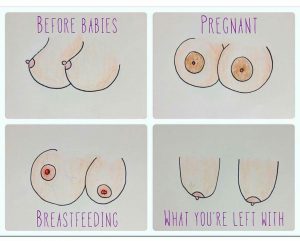When most people think about a changing pregnant body, they imagine a swelling belly. I’m here to remind you to look just a little further up. Breasts undergo significant changes, both during and after pregnancy.
First Trimester
Breast changes may be one of the first signs that you’re expecting! A feeling of fullness or heaviness, swollen breasts, tenderness, or extra-sensitive nipples can show up in the first few weeks of pregnancy, possibly even before your missed period.
Your body starts to prepare for breastfeeding right away. The heaviness, tenderness, and firmness you feel come from increased blood flow and growth in your milk ducts and mammary glands. Your body adds fatty tissue in the breasts as well.
What to do: Skip over-the-counter pain meds if you can. They won’t help tenderness or sensitivity much. Buy new bras if you need, but pick inexpensive options if possible. You may have a long way to go.
Second Trimester
Breasts continue to grow, and they may start to look very different. Your nipples and areolas may change color. Nipples can become more prominent, and areolas can become larger and darker (some experts think the extra color contrast acts as a “target” to help babies find the nipple to nurse). The increased blood flow can make more veins noticeable on your breasts. Stretching skin can also get itchy.
What to do: Skin creams won’t do much about stretch marks (those are defined by genes), but moisturized skin is usually less itchy.
If you’re feeling self-conscious about breast changes, talk with your partner. This is a unique time in your life. Most color changes go more or less back to normal after pregnancy, so you might enjoy giving your breasts some extra attention and praise during intimate moments.
Third Trimester
Your body’s ramping up for breastfeeding even harder now. You may jump yet another cup size and have to replace your bras all over again (that’s why you bought cheap ones earlier). And surprise! You may now have nipples that leak a thick fluid called colostrum, which is a nutritious substance your body makes before mature milk comes in. Stimulation, including during sex, can trigger a let-down.
What to do: Buy cloth or disposable nipple pads if you need them to deal with leaking. Think about buying comfortable bras to sleep in, too (you may need extra support).
After Pregnancy
Milk engorgement can take breasts into Baywatch lifeguard proportions, if they weren’t there already. You’ll produce colostrum for the first couple days, and then mature milk should come in.
What to do: Breastfeeding? Ditch underwire bras. They can press on milk ducts and interfere with production (not to mention cause discomfort). Stock up on a nipple cream, such as lanolin, to keep nipples moisturized and protected, which can prevent or minimize cracking. Nurse around the clock as your baby’s hunger demands, which will also signal your body to boost milk supply.
If you’re not breastfeeding, your body will still make milk for a while. Try to avoid pumping to relieve pressure, as this can extend the time your body produces milk. Instead, wear a tight sports bra around the clock as much as possible, and relieve discomfort by applying a bag of frozen peas.
As far as breast sagging, you’re bound to hear a lot of advice. Keeping weight gain in check and choosing supportive bras helps to a certain extent. Some fitness enthusiasts swear by push-ups to lift the pectoral muscles under the breast and contribute to extra perk.
The reality is most breast droopiness is ultimately decided by genetics. We’re of the opinion that being a “lucky” mom has much more to do with the chance to cuddle a baby to your chest than how much lift that chest has.

